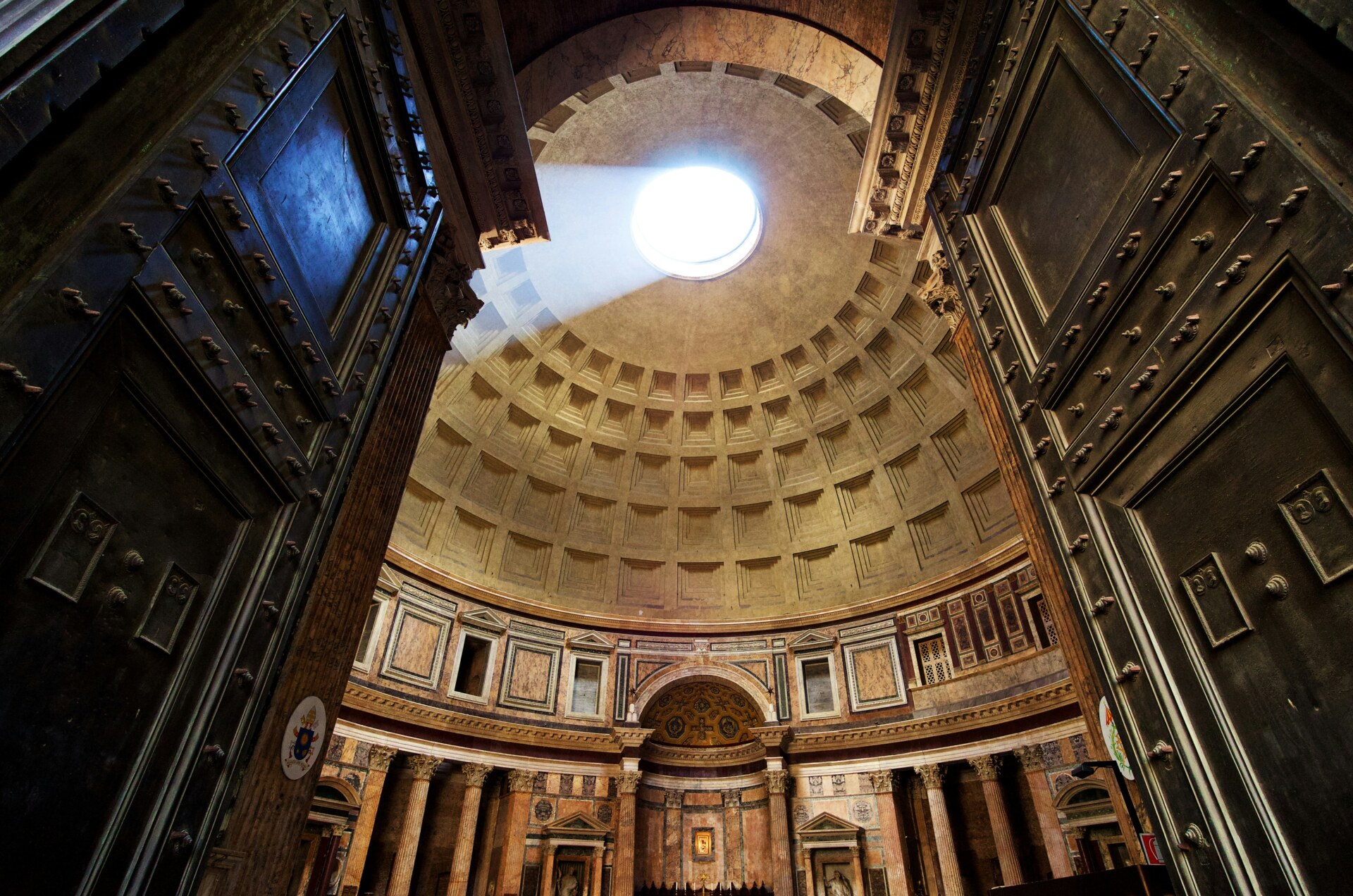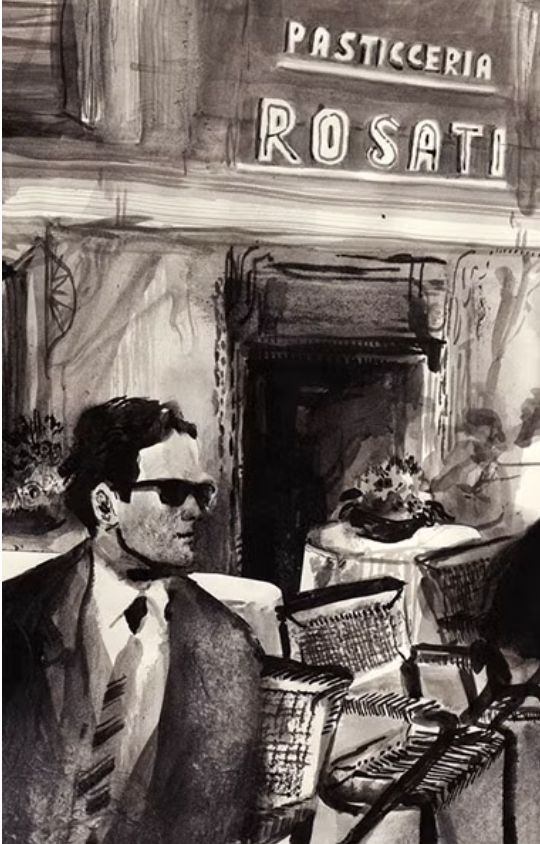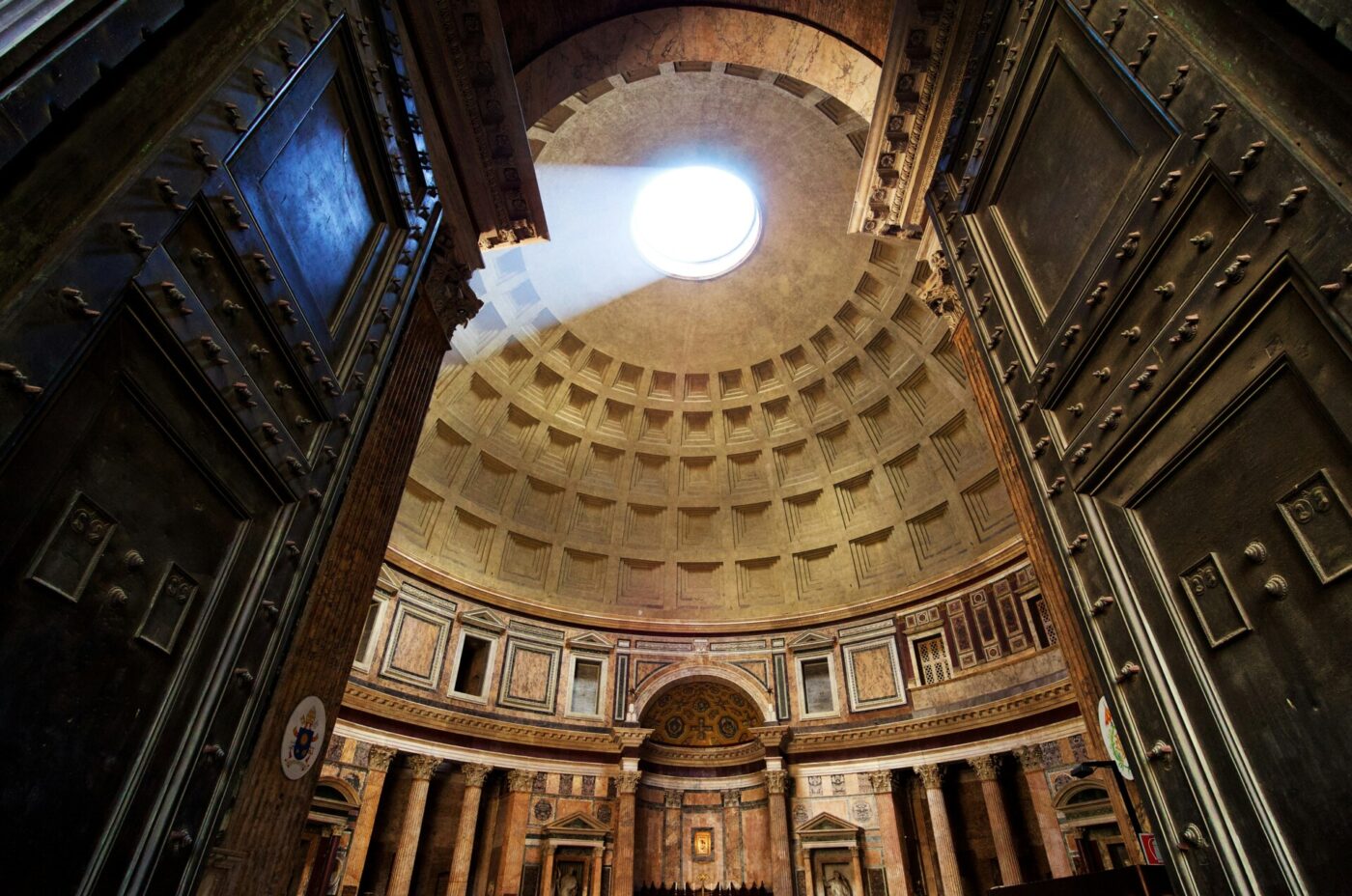Rome. Italy’s capital city is not just Eternal, nor just one of the world’s most beautiful urban centers, but the capital of Italian cinema. The link between the Eternal City and the seventh art is undeniable, deep and indissoluble. This chaotic city has been a muse for directors like Sorrentino, Pasolini and Fellini; the home of Cinecittà studios; and the social playground of decades of cinematic stars. Its streets have been chosen to tell stories of love and friendship, drama and horror, noir and innocence. To walk around Rome is to immerse oneself in a film set. Here, a guide to the Roman places made famous by the cinematic spotlight:

Spanish Steps
SIGHTS AND STREETS
VIA VENETO
Let’s start our itinerary in cinematic Rome at the symbol of la dolce vita years. Via Veneto–a beautiful street that runs through the heart of Rome, from Piazza Barberini to Porta Pinciana–is where the biggest names in film and television flocked in the 1950s, 1960s and early 1970s: Eva Gardner, Burt Lancaster, Elizabeth Taylor, Marcello Mastroianni, and scores more. Treat yourself to some shopping or a leisurely breakfast at one of the elegant establishments here (Harry’s Bar and Cafe Doney) and you will feel like a star, if only for a while. Many Hollywood producers have even used this street as a film set, and its clubs and hotels as meeting places. Although Fellini made it famous with his classic film La Dolce Vita, he actually reconstructed the iconic street within the walls of the Cinecittà studios.
SPANISH STEPS
An obligatory stop on our itinerary, a location whose charm is contributed to by the Barcaccia fountain, created by Pietro and Gian Lorenzo Bernini, and the beautiful Trinità dei Monti Church. Precisely because of its scenic beauty, this staircase has been chosen as a set for some of the most famous films in the history of cinema: here, the princess played by Audrey Hepburn in Roman Holiday, bored by the rigid label of court life, finds love in the arms of Gregory Peck; here, the destinies of the three melancholy seamstresses Marisa, Lucia and Elena unfold in The Girls of the Spanish Steps; here, Nicola jokes with Luciana, the beautiful Stefania Sandrelli, arousing Antonio’s jealousy in We Were So Loved.
Near the Spanish Steps, one cannot fail to mention the little street Via Margutta, once populated by stables and workshops, then made famous by the big screen: the house of the protagonist of Roman Holiday is located right here. And that’s not all: Federico Fellini, Anna Magnani, Giulietta Masina, Giorgio de Chirico and Novella Parigini all lived on Via Margutta.
PALAZZO DEI CONSERVATORI
Part of the Capitoline Museums, the 15th-century Palazzo dei Conservatori is great for the entire collection of statues, paintings and frescoes, but head to the courtyard to see the fragmented feet of the Colossus of Constantine–also admired by Matt Damon in Anthony Minghella’s The Talented Mr. Ripley (1999).
TREVI FOUNTAIN
The Trevi Fountain is perhaps, along with the Colosseum, one of Rome’s most iconic monuments, in part thanks to Fellini’s one and only La Dolce Vita (1960), in which Anita Ekberg and Marcello Mastroianni famously enter its waters. It’s a scene that has made its way into scores of other movies (how meta!): in Lost in Translation, the protagonists watch the scene on TV; in Fellini’s L’Intervista, the scene is introduced by Marcello Mastroianni himself and replayed in the living room of Anita Ekberg herself; Ettore Scola’s film C’eravamo Tanto Amati (1974) stages a hyper-meta behind-the-scenes in which Fellini and Matroianni play themselves. In Monicelli’s Risate di Gioia (1960), we also find Anna Magnani in an evening dress at the Trevi Fountain.
PIAZZA NAVONA
Another symbol of Rome and very popular among international productions, Piazza Navona appears in the opening scene of Ridley Scott’s All the Money in the World (2017) on the kidnapping of young John Paul Getty III; Scott had the entire Roman square decorated in the typical style of the 1970s.
We also find the square again in Anthony Minghella’s The Talented Mr. Ripley (1999): a long scene features protagonists Tom Ripley (Matt Damon) and Meredith Logue (Cate Blanchett) chatting as they stroll through the heart of the Eternal City between Piazza Navona and the Spanish Steps.
(Fun history fact: Originally built on the site of Domitian’s Stadium in the first century AD, the square was used for athletic games and other public events.)
FONTANA DELL’ACQUA PAOLA
Among the most romantic places in the Eternal City is undoubtedly the terrace of the Janiculum Hill: offering a panoramic view of Rome, at sunset the hill becomes a meeting point for friends and lovers, who linger here until the stars come out. Its famous “fontanone” (literally “big fountain”, a nickname) is the set for the first scene of Paolo Sorrentino’s La Grande Bellezza (2013), which won the Foreign Language Film Oscar and many other international awards. The cannon at noon, the sacred and the profane, the Stendhal syndrome: the first scene of La Grande Bellezza is an evocative experience of this Roman spot.
PORTA PORTESE
In the Trastevere district, one can find the plaque in memory of the film Ladri di Biciclette (1948) directed by Vittorio De Sica. To find his stolen bicycle, protagonist Antonio goes to Porta Portese, once a market for stolen goods. (He also desperately searches for the bicycle in many other popular areas of the city, such as Piazza Vittorio, the Flaminio Stadium, the bridges over the Tiber and Via di Val Melaina.) The famous market, which is still held every Sunday, was also the set for Monicelli’s masterpiece I Soliti Ignoti when there’s an attempted camera theft–one of the great gags from the 1958 film, which features a gang composed of Gassmann, Mastroianni and other great actors of Italian cinema.
IL PIGNETO
Finally, outside the main attractions of Rome, to the east, lies the Pigneto neighborhood. Because of its working-class and proletarian soul, Pigneto (and the entire southeastern area of Rome: Prenestino, Casilino and Tuscolano) was particularly beloved by the directors of neorealism (Luchino Visconti, Pietro Germi, Nanni Loy, etc.). Roma Città Aperta (Roberto Rossellini, 1945) starring Anna Magnani and Aldo Fabrizi, was shot in the neighborhood, but its streets could not have been more perfect than for the characters of Pier Paolo Pasolini. Accattone (1961) marked the neighborhood. The main locations seen in the film are Via Fanfulla and Bar Necci: the latter was the real beating heart of Pasolini’s film, the meeting place of the “boys of life” narrated by Pasolini, and a spot frequented by the director and the cast of the film.
THE PANTHEON
Baroque Rome, between the Pantheon and Piazza Farnese, is the magnificent backdrop for a cinematography that has been used to evoke diverse suggestions: popular or aristocratic, lighthearted or cynical, mysterious or dramatic aspects merge in the history of alleys, monuments and palaces.
In Piazza della Rotonda, the great Vittorio De Sica shot a dramatic scene from Umberto D. (1952), one of the most significant films of Italian Neorealism. A former ministerial official, Umberto can no longer live on his meager pension and finds himself begging under the Pantheon’s colonnade. When he meets an acquaintance, ashamed, he pretends to be there by accident. No film has so poignantly expressed the loneliness of old age, aggravated by the country’s meager economic opportunities.

The Pantheon
BARS
The go-tos of the cinema world.
HARRY’S BAR
Legendary Harry’s Bar, the only place that evokes the La Dolce Vita as if it were a screenshot taken straight from the movie, is the place to go for a flashback to the golden age of Via Veneto, when Frank Sinatra played piano and every glamorous star made an appearance here. As in the roaring 60s, you can still have an aperitif, enjoy the piano bar every night, and see and be seen. Their specialty is Bellini cocktails.
CAFFÈ DONEY
The historic Caffè Doney on Via Veneto, part of the Westin Excelsior Hotel, is famous for having been an international crossroads for big stars of the 1950s and 1960s. Historically the cradle of fashion and trendsetting, today the bar serves as an intimate and cozy salon.
Open daily from 8 am to 11 pm, the caffè is open from breakfast to after dinner with a menu of various regional offerings: Venetian cicchetti and Sicilian panelle, Puglian panzerotti and Romagnan piadine, Roman supplì and white pizza with porchetta.
ANTICO BAR MARIANI
Antico Bar Mariani, located in Via dei Pettinari for five generations and 160 years, was a favorite of Carlo Verdone (who lived in the same building), Alberto Sordi (who lived nearby) and Ettore Scola. Open from 6AM to 9PM, the bottega storica is great for a coffee at any hour or a stuffed pizzetta at lunchtime. With vintage signs, tables and contraptions, the bar is always ready to be a movie set.
BAR ROSATI
Since the 1920s, Caffè Rosati has been a cult spot for high-profile figures of the art world and the intelligentsia who have gravitated to Rome. The historic café in Piazza del Popolo was frequented by painters from Via Margutta and the great poet Trilussa, who liked to spend time in the more reserved inner room. In the 1960s, an unfailing guest was Federico Fellini as well as eminent writers like Pier Paolo Pasolini, Italo Calvino and artists such as Mario Schifano.
Even today, Rosati maintains its appeal among domestic and international entertainers. The sunny outdoor seating is great for a pastry-based Italian breakfast or aperitivo.

Illustration of Pier Paolo Pasolini, Courtesy of Bar Rosati
RESTAURANTS
The favorites of Italian actors and directors.
TRATTORIA BIONDO TEVERE
Opened in 1914, this restaurant, with a pergola-covered terrace overlooking the river, was chosen in 1951 by Luchino Visconti for a family lunch scene in Bellissima with Anna Magnani.
The trattoria was also a favorite of Pier Paolo Pasolini, who dined there the night before he was killed. The restaurant favors typical Roman cuisine via meat and fish specialties. The pizza is Roman–thin and crispy. Absolutely don’t miss the artichoke alla giudia.
LA VERANDA DELL’HOTEL COLUMBUS
Near the end of Paolo Sorrentino’s La Grande Bellezza, Jep (Toni Servillo) goes on a date to this picturesque restaurant on Borgo di Santo Spirito. In a 15th-century building, the upscale spot has beautiful frescoes and a vaulted ceiling. Don’t miss the candlelit garden when the weather’s nice.
NECCI DAL 1924
In Pigneto, the Necci bar has been an institution for as long as we can remember. The elderly have played cards in the morning here since as early as the 1920s and didn’t even stop when Pasolini was filming Accattone (1961) there. Necci is not only a restaurant, but a place for the locals of the neighborhood to gather. You can find homemade dishes including cornettos, pasta, pizza and desserts.
LE TAVERNELLE
A historic restaurant in the Monti district, Le Tavernelle was a favorite of numerous actors and directors, including the great Federico Fellini. Photos of the illustrious customers abound on the walls of the restaurant. The cuisine is typical Roman and served in generous portions.
OSTERIA MARGUTTA
Osteria Margutta, located just a stone’s throw from the Spanish Steps, has been open since 1965 and boasts lively jazz music. Chairs are dedicated to the notable guests who have visited, including de Filippo, Fellini, Giulietta Masina and Woody Allen, who filmed scenes of To Rome with Love there in 2012. The menu at Osteria Margutta is noteworthy as well, featuring Margutti’s signature caponatina, chickpea and clam soup, fusilli with cinnamon ragu, beef tartare with grappa and Petit Verdot filet with cocoa and pink pepper.

Courtesy of Necci Dal 1924
MOVIE THEATERS
To conclude this journey in cinematic Rome, what better way than by going to one of Rome’s historic theaters to see a film yourself?
CINEMA FARNESE PERSOL
Among the most popular and well-known arthouse cinemas (cinema d’essai) in the capital, the historic cinema in Campo de’ Fiori was built in the late 1800s. Today, the theater is known for its diverse programming, which includes a mix of classic, foreign and independent films.
NUOVO SACHER
In 1991, the then-inoperative facility in Trastevere was purchased by Sacher Film, the film production company of Nanni Moretti and Angelo Barbagallo, to offer programming of lesser-known auteur films. Today, the small cinema has both an indoor and outdoor, summertime theater.
CINEMA ADRIANO
Founded in 1898 as a playhouse, Cinema Adriano is one of the oldest theaters in the capital, designed by renowned architect Luigi Rolland and located in Piazza Cavour. Choose the film being shown in the vast horseshoe-shaped hall, decorated in white and gold, with a Baroque-inspired ceiling frescoed by set designer Alessandro Bazzani.
CINEMA GREENWICH
Established in the 1920s as Clemson Hall, a parish cinema of the Salesians, the Testaccio neighborhood cinema is now a multiplex specializing in arthouse films.



